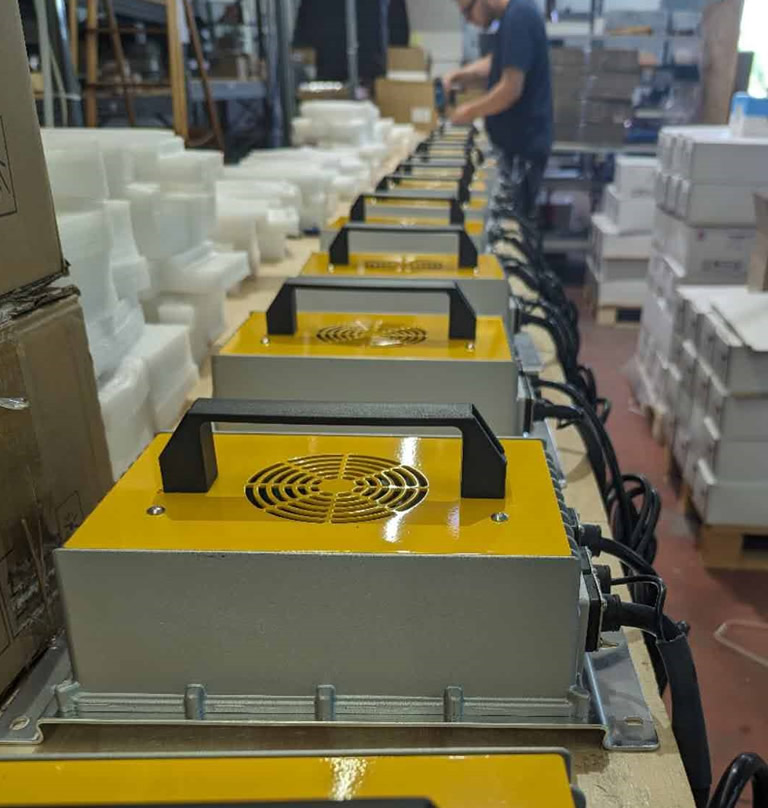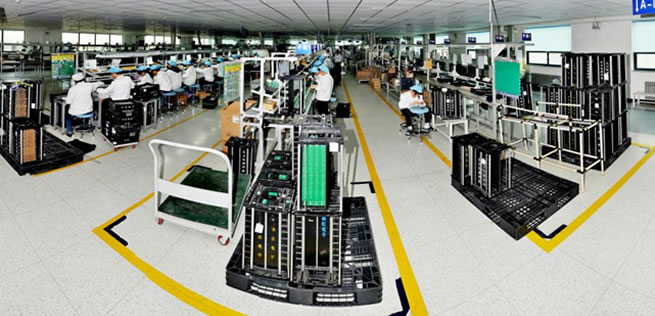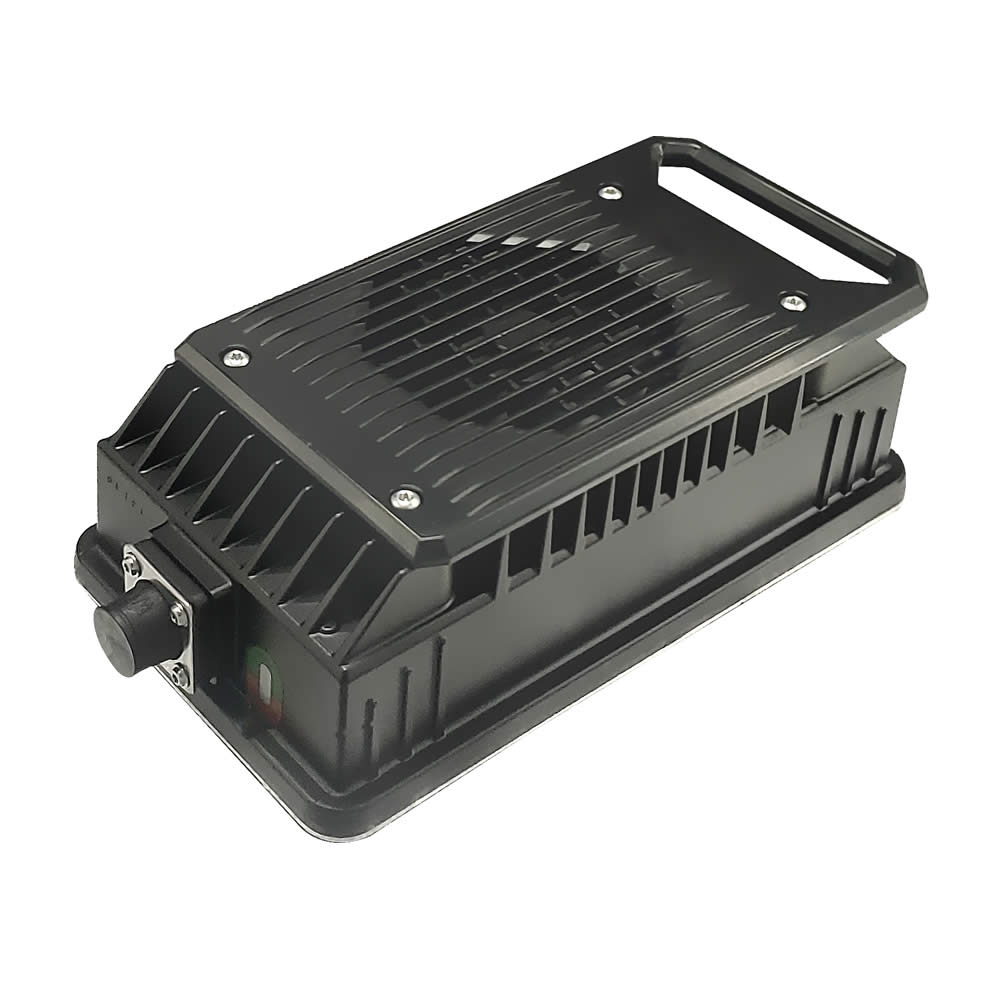When it comes to choosing the right battery for your needs, understanding the distinction between industrial and regular batteries is crucial. This guide will explore the fundamental differences between these two battery types, helping you make informed decisions for your specific applications.
What Defines a Battery?
A battery is a device that stores chemical energy and converts it to electrical energy through electrochemical reactions. This energy conversion allows batteries to provide power to a multitude of devices, from small household items to large industrial machinery.
Understanding Battery Basics
At its core, a battery functions as a power source by facilitating an electrochemical reaction. This reaction involves electrons moving from one material to another, thus generating an electric current that can be harnessed for practical use.
Components
The fundamental components of all batteries include:
- Anode (Negative Electrode): The anode releases electrons during the electrochemical reaction, providing the negative charge.
- Cathode (Positive Electrode): The cathode accepts electrons when the battery is discharging, completing the circuit within the device.
- Electrolyte: A chemical medium that allows the ionic movement necessary for the electrons to flow between the cathode and anode.
- Separator: A physical barrier that keeps the cathode and anode apart to prevent electrical shorts, while allowing the ionic flow through the electrolyte.
What are the Different Types of Batteries?
There are two basic types of batteries that are commonly used;
- Primary Batteries
Primary batteries are designed for single-use and cannot be recharged. Their chemical reactions are irreversible, leading to the exhaustion of the active materials after one cycle. Common examples include alkaline batteries typically used in remote controls and flashlights.
- Secondary Batteries
Unlike primary batteries, secondary batteries can be recharged and reused multiple times. They operate on reversible chemical reactions, allowing them to restore their charge state through an external electrical energy source. This category includes lithium-ion batteries, widely used in mobile phones and laptops due to their high energy density and durability.
Is There a Difference Between Industrial and Consumer Batteries?
Indeed, the main difference between industrial and consumer batteries lies in their design and intended use. Industrial batteries are crafted to withstand harsh conditions and provide long-term reliability for critical applications, often featuring higher energy densities and durability. They are essential in settings where failure can result in significant operational disruptions. Conversely, consumer batteries are typically designed for lighter use in everyday devices such as remote controls, smartphones, and laptops, focusing on cost-effectiveness and convenience rather than extreme longevity or robustness.
What are Industrial Batteries?
Industrial batteries are high-performance units designed to meet rigorous energy demands and challenging environmental conditions. They often employ advanced technologies and materials that offer enhanced efficiency, higher capacity, and greater resistance to temperature extremes and physical stress. This makes them suitable for critical applications in industrial and commercial settings where reliable power is essential for continuous operation.
What are the Common Types of Industrial Batteries
- Lead-Acid Batteries: One of the oldest and most reliable types, known for their ability to provide high surge currents despite their relatively low energy density.
- Nickel-Cadmium (NiCd): Known for their excellent discharge rates and stability, these batteries are used in applications requiring durability and a high number of charge cycles.
- Lithium-Ion (Li-ion): These batteries offer a high energy density and are commonly used in high-tech applications due to their lightweight and long lifecycle.
- Nickel-Metal Hydride (NiMH): Providing a good balance between cost and performance, NiMH batteries are used in applications where environmental concerns are prioritized, as they contain no toxic metals.
Usage Scenarios
- Lead-Acid Batteries: Predominantly used in power backup systems and heavy machinery due to their high power output and affordability.
- Nickel-Cadmium Batteries: Ideal for aerospace and emergency backup applications where reliability is crucial.
- Lithium-Ion Batteries: Commonly used in electric vehicles and portable power tools due to their lightweight and high efficiency.
- Nickel-Metal Hydride Batteries: Often utilized in medical equipment and hybrid vehicles where less environmental impact is desired.
What are the Common Types of Consumer Batteries
- Alkaline Batteries: These are the most prevalent type of consumer batteries, ideal for devices with moderate to low power requirements due to their long shelf life and stability.
- Lithium Batteries: Known for their high energy density and ability to operate in a wide range of temperatures, making them suitable for high-drain devices like cameras and smart devices.
- Nickel-Metal Hydride (NiMH): Rechargeable batteries that serve as a more environmentally friendly option, commonly used in household electronics that require frequent use.
- Nickel-Cadmium (NiCd): One of the earliest types of rechargeable batteries, offering high discharge rates but less favored due to memory effect and environmental concerns.
- Zinc-Carbon Batteries: Cost-effective and suitable for low-drain devices like clocks and remote controls, but with a shorter life span and lower energy density compared to others.
Usage Scenarios
- Alkaline Batteries: Ideal for toys, clocks, and remote controls due to their long life and stable output.
- Lithium Batteries: Preferred for high-performance devices such as digital cameras and gaming controllers, thanks to their long-lasting and high-power capabilities.
- Nickel-Metal Hydride Batteries: Commonly used in household devices like cordless phones and electric razors that require frequent recharging.
- Nickel-Cadmium Batteries: Used in power tools and medical devices where high discharge rate is necessary.
- Zinc-Carbon Batteries: Best suited for low-drain devices due to their cost-effectiveness but limited capacity.
Usage in Everyday Life
Regular consumer batteries power a diverse array of devices, including:
- Remote Controls: Often powered by AA or AAA alkaline batteries.
- Cell Phones: Many use lithium-ion batteries for extended life and efficient charging.
- Digital Cameras: Typically use lithium or rechargeable nickel-metal hydride batteries for higher energy requirements.
- Portable Audio Devices: Such as MP3 players, often use lithium-ion batteries for longevity.
- Smoke Detectors: Commonly powered by 9-volt alkaline batteries or long-life lithium batteries to ensure functionality over extended periods.
Replacement and Maintenance
- Check battery contacts for corrosion and clean them regularly to ensure optimal performance.
- Store batteries at room temperature and in a dry environment to prolong their life.
- For rechargeable batteries, avoid letting them discharge completely before recharging to maximize lifespan.
- Always dispose of old batteries at proper recycling facilities to prevent environmental harm and potential hazards.
- Replace batteries once devices start to show signs of slowed performance or when the battery no longer holds a charge as it used to.
How Do Industrial and Regular Batteries Differ?
Industrial and regular consumer batteries are designed for fundamentally different applications, leading to distinct variations in their chemical compositions and physical designs. Understanding these differences is crucial for choosing the right battery type for specific needs, ensuring both efficiency and longevity.
Chemical Composition
Materials Used
The materials used in industrial and regular batteries differ significantly to accommodate their intended uses:
Industrial Batteries
- Lead-Acid: Commonly used for its reliability and high power output, suitable for backup systems and heavy machinery.
- Nickel-Cadmium: Known for excellent performance in extreme conditions, offering high durability.
- Lithium-Ion: Provides high energy density for applications requiring lightweight and long-lasting energy solutions.
Regular Consumer Batteries
- Alkaline: Widely used in household devices for its cost-effectiveness and reliable performance under typical usage conditions.
- Nickel-Metal Hydride: Favored in consumer electronics for its environmental friendliness and ability to be recharged multiple times.
- Lithium: Used in high-drain devices like digital cameras and smartphones due to its long life and high energy capacity.
Nominal Voltage
The nominal voltage of a battery indicates the standard operating voltage it provides. Typically, industrial batteries have higher nominal voltages compared to regular consumer batteries due to the heavier loads and longer usage durations they must support. For instance, industrial batteries may operate at 12 volts or higher for heavy machinery and backup systems, while standard consumer batteries like AA or AAA types typically provide 1.5 volts, suitable for household devices such as remote controls and toys.
Energy Density
Energy density is a critical parameter that measures the amount of energy a battery can store relative to its size or weight, expressed in watt-hours per kilogram (Wh/kg). This characteristic is pivotal because it affects both the endurance and portability of battery-powered devices.
Comparison
Industrial Batteries: These batteries often have higher energy densities to meet the requirements of demanding applications. For example, lithium-ion batteries used in industrial contexts might offer energy densities as high as 250 Wh/kg, facilitating longer operation times and more robust power delivery suitable for critical infrastructure and electric vehicles.
Regular Consumer Batteries: Typically, these have lower energy densities as the devices they power require less energy. Alkaline batteries, common in household settings, might have energy densities around 100 Wh/kg, which is sufficient for lighter-use electronics and daily tasks.
Lifespan and Durability
Expected Lifespan
- Industrial Batteries: These batteries are built to last longer due to the demanding environments they operate in. Typically, industrial batteries such as deep-cycle lead-acid or industrial-grade lithium-ion can last between 5 to 20 years, depending on usage patterns and maintenance.
- Regular Consumer Batteries: In contrast, consumer batteries, like alkaline or standard lithium-ion cells used in everyday electronic devices, generally have a shorter lifespan, ranging from a few months to about 3 years.
Durability Factors
The durability of batteries is greatly influenced by environmental factors such as:
- Temperature: Industrial batteries are often designed to withstand extreme temperatures, both high and low, which might degrade regular batteries more rapidly.
- Vibration and Shock: Industrial batteries are also constructed to endure harsher physical conditions, including constant vibrations and impacts, unlike regular consumer batteries.
- Cyclic Load: Industrial batteries usually support a higher number of charge and discharge cycles compared to consumer batteries, which are not typically designed for heavy or deep cyclic use.
Applications of Industrial vs Regular Batteries
Industrial and regular batteries serve different purposes based on their engineered capabilities:
Industrial Batteries: Used in applications requiring reliability under tough conditions, such as in UPS systems for data centers, emergency power for hospitals, or motive power for forklifts.
Regular Batteries: Primarily used in consumer electronics, such as laptops, cell phones, and household gadgets that require less power and are used in more controlled environments.
Where are Industrial Batteries Used?
Industrial batteries are employed in environments and applications where reliability and endurance are critical. Typical uses include:
Telecommunications: Ensuring continuous operation of communication networks.
Emergency Power Systems: Providing backup power to hospitals and data centers during outages.
Renewable Energy Systems: Storing excess energy generated by wind or solar installations.
Material Handling Equipment: Powering electric forklifts and other warehouse vehicles.
Transportation Infrastructure: Supporting signaling, lighting, and other critical systems in rail and air transit systems.
Everyday Uses of Regular Batteries
Regular batteries, also known as consumer batteries, are found in many everyday devices. Common applications include:
- Remote Controls: Often powered by AA or AAA batteries.
- Smartphones and Portable Electronics: Utilizing rechargeable lithium-ion cells.
- Watches and Calculators: Typically using button cells.
- Toys and Games: Commonly powered by AA or AAA batteries, sometimes C or D cells for larger items.
- Flashlights and Emergency Gear: Using various battery types from AA to specialized lithium batteries depending on the required longevity and brightness.
- Wireless mice and keyboards
- Digital cameras & Portable speakers
Charging
The charging processes for industrial and regular consumer batteries vary significantly due to their design and intended usage environments. Industrial batteries are often designed to be charged quickly and frequently without degrading their overall lifespan, supporting heavy-duty applications. In contrast, regular consumer batteries are typically charged at a slower rate, with a focus on maximizing lifespan and safety for everyday use.
What Is The Difference Between An Industrial Battery Charger And A Regular Consumer Battery Charger?
Let’s take a look at the major differences between the industrial and regular battery charger;
- Industrial Battery Chargers
Voltage and Amperage: Industrial chargers often deliver higher voltages and amperages to accommodate the larger capacity and quicker charging needs of industrial batteries. For example, an industrial battery charger might provide 48 volts and 50 amps to efficiently charge large battery banks.
Safety Features: These chargers are equipped with advanced safety features to handle the high power output, including temperature monitoring, overcharge protection, and automatic shutdown mechanisms.
Wattage: Higher wattage ratings are common in industrial chargers to ensure rapid charging without damaging the batteries, often ranging into several kilowatts.
- Regular Consumer Battery Chargers
Voltage and Amperage: Consumer chargers typically operate at lower voltages and amperages, suitable for smaller batteries. A typical consumer charger might offer 5 volts and 1-2 amps.
Safety Features: While also focusing on safety, consumer chargers generally incorporate basic safety features such as short-circuit protection and thermal cutoffs.
Wattage: The wattage of consumer battery chargers is significantly lower, often less than 10 watts, reflecting their use in less demanding, everyday environments.
- Technical Factors Comparison
Industrial chargers are robust, designed to charge batteries faster and to accommodate the rigorous demands of industrial environments. They have to manage higher energy throughput effectively, thus are built with more robust materials and technologies.
For instance, a typical industrial charger used in a warehouse for forklift batteries must rapidly charge high-capacity lead-acid batteries overnight without overheating or causing wear. In contrast, a household battery charger for AA or AAA batteries charges slowly to preserve the batteries’ longevity, using much simpler charging technology.
Operating Temperature
Industrial batteries are typically designed to operate under more extreme conditions, which makes them suitable for environments ranging from very cold to extremely hot. These batteries often function optimally within a temperature range of -20°C to 60°C. This broad range allows them to be used in heavy machinery and outdoor applications where temperatures can vary drastically.
Regular consumer batteries, on the other hand, have a narrower operating temperature range, typically from 0°C to 45°C. This range is sufficient for most household and personal devices, which are usually used in more controlled environments.
Charging Temperature
Industrial Batteries can be charged at temperatures from -10°C to 50°C. The ability to charge at lower temperatures is particularly beneficial for batteries used in outdoor equipment or in refrigerated areas, where temperatures can be below freezing.
For consumer batteries, the charging temperature is generally limited to a range of 0°C to 40°C. Charging outside of this range can lead to reduced battery life and increased risk of damage or failure. This range is adequate for typical home and office environments.
Maintenance Practices
Maintaining batteries effectively ensures they perform optimally throughout their life cycle. Here’s how maintenance varies between industrial and regular batteries:
Routine Checks and Balancing: Steps for Maintaining Industrial Batteries
- Visual Inspections: Regular visual checks to identify any signs of damage or leakage.
- Voltage and Current Tests: Frequent testing to ensure they are operating within their specified parameters.
- Equalization Charges: Periodically applying an equalization charge to balance cell voltages and prevent sulfation.
Regular Battery Care: Tips for Extending the Life of Regular Batteries
- Avoid Complete Discharge: Avoid letting batteries discharge completely before recharging to prevent deep cycle wear.
- Clean Contacts: Regularly clean battery contacts to ensure efficient power transfer and prevent corrosion.
- Proper Storage: Store in a cool, dry place at a moderate charge level to prolong shelf life.
Differences in Maintenance
- Industrial batteries require more rigorous and technical maintenance routines due to their complex designs and harsh operating environments.
- Regular consumer batteries benefit from simpler maintenance practices, focusing on prolonging life and ensuring safety in everyday electronics.
Safety Guidelines
Safety is paramount when dealing with any battery type, given their chemical nature and potential hazards.
Handling and Storage: Safety Practices for Both Battery Types
Proper Handling: Always handle batteries with care to avoid punctures or drops that could lead to internal shorts or leakage.
Appropriate Storage: Store batteries away from flammable materials and in non-conductive containers to prevent short circuits.
Emergency Procedures: What to Do in Case of a Battery Failure
Industrial Batteries
- Isolate the battery to prevent further damage to the electrical system.
- Ensure adequate ventilation around the battery to disperse any hazardous gases released.
Regular Batteries
- Immediately stop using the device if the battery shows signs of failure.
- Dispose of batteries at designated recycling centers to prevent environmental harm and reuse valuable materials.
Conclusion
Whether you’re managing a fleet of industrial machinery or simply looking to power your household devices, selecting the right battery type enhances performance and extends lifespan, ensuring that energy needs are met efficiently and safely.
Keep in mind that industrial batteries are designed for durability and higher performance under extreme conditions, whereas regular batteries are optimized for common electronic devices and household use.
Your choice on battery type isn’t just about cost; it’s about matching the battery to the demands of the environment and the devices they power.






